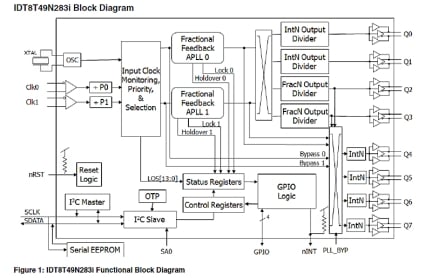Overview
Description
The 8T49N283I has two independent, fractional-feedback PLLs that can be used as jitter attenuators and frequency translators. It is equipped with six integer and two fractional output dividers, allowing for the generation of up to eight different output frequencies, ranging from 8kHz to 1GHz. Four of these frequencies are completely independent of each other and the inputs. The other four are related frequencies. The eight outputs may select among LVPECL, LVDS, or LVCMOS output levels.
Renesas' third-generation Universal Frequency Translator family also includes the 8T49N281i (2-in/1-PLL/8-out) and the 8T49N282i (4-in/2-PLL/8-out).
To see other devices in this product family, visit the Universal Frequency Translators page.
Features
- Two differential outputs meet jitter limits for 100G Ethernet and STM-256/OC-768
- <0.3ps RMS (including spurs): 12kHz to 20MHz
- Accepts up to two LVPECL, LVDS, LVHSTL, or LVCMOS input clocks ranging from 8kHz up to 875MHz
- Auto and manual input clock selection with hitless switching
- Clock input monitoring, including support for gapped clocks
- Phase-Slope Limiting and Fully Hitless Switching options to control output phase transients
- Operates from a 10MHz to 40MHz fundamental-mode crystal
- Generates eight LVPECL/LVDS or sixteen LVCMOS output clocks ranging from 8kHz up to 1.0GHz (diff), 8kHz to 250MHz (LVCMOS)
- Register programmable through I2C or via external I2C EEPROM
- Supported by Renesas' Timing Commander™ software
Comparison
Applications
- OTN or SONET/SDH equipment line cards (up to OC-192, and supporting FEC ratios)
- OTN de-mapping (Gapped Clock and DCO mode)
- Gigabit and Terabit IP switches/routers including support of Synchronous Ethernet
- Wireless base station baseband
- Data communications
Design & Development
Software & Tools
Software & Tools
| Software title
|
Software type
|
Company
|
|---|---|---|
| Timing Commander Timing Commander™ is an innovative Windows™-based software platform enabling system design engineers to configure, program, and monitor sophisticated timing devices with an intuitive and flexible graphical user interface (GUI).
|
Code Generator | Renesas |
1 item
|
||
Models
ECAD Models
Schematic symbols, PCB footprints, and 3D CAD models from SamacSys can be found by clicking on products in the Product Options table. If a symbol or model isn't available, it can be requested directly from the website.

Product Options
Applied Filters:
Videos & Training
Description
Transcript
News & Blog Posts
| Benefits of a Point-of-Use Clock for Jitter Optimization | Blog Post | Apr 27, 2021 |



